
Search Wild Foods Home Garden & Nature's Restaurant Websites:
Juniper
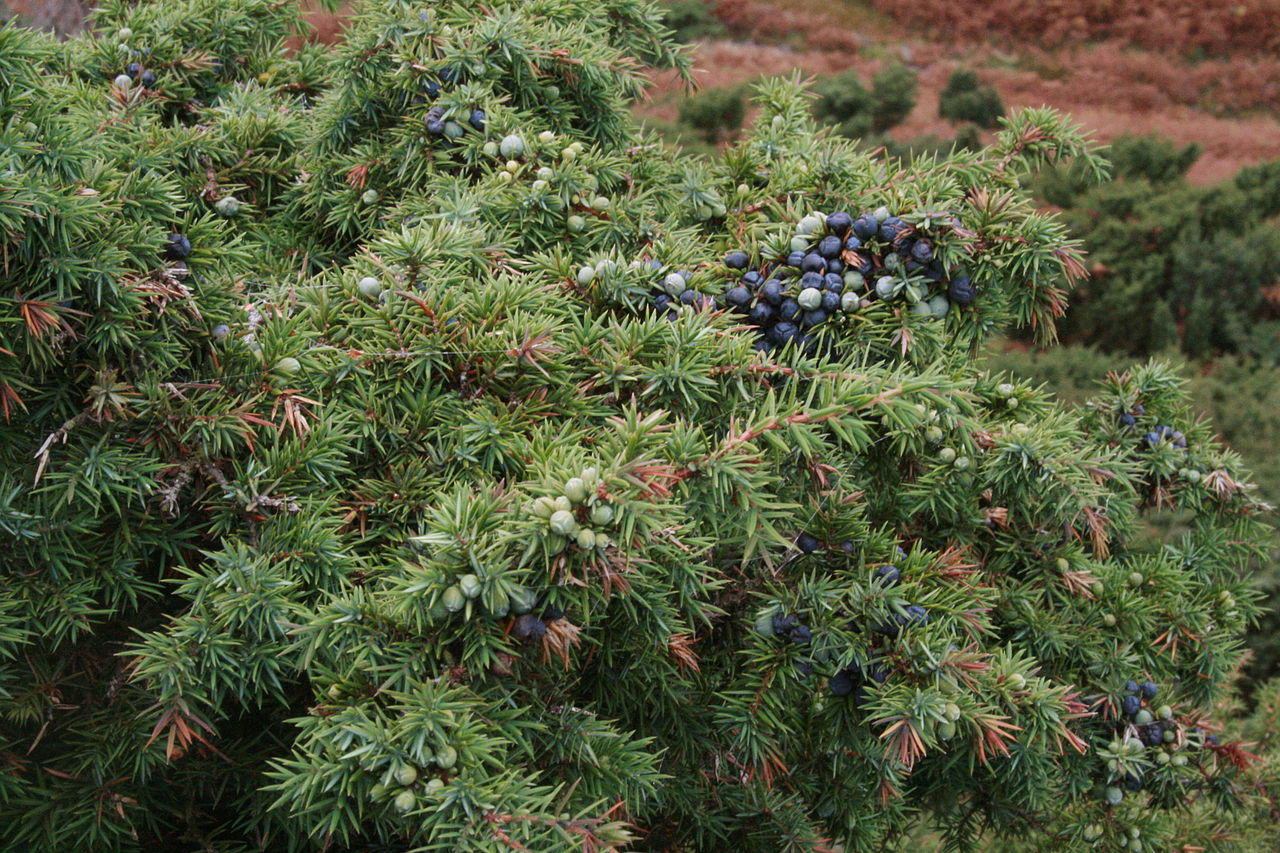
Common Juniper (Juniperus communis). This is the best one to grow for harvesting the fruit. (By: Chris Cant Attribution 2.0 Generic)
(NOTE: If you are not interested in growing the Juniper, but just finding the tree/shrub and using the berries, try going to the Nature's Restaurant Online site for Juniper Berries.)
Juniper Berries. There are lots of different trees in the Juniper (Juniperus) family. There are three native Junipers that I know of in the Eastern part of North America, the Common Juniper (Juniperus communis), the Creeping Juniper (Juniperus horizontalis) and a tree called the Eastern Red Cedar (Juniperus virginiana). It is oddly called a Cedar, even though it is not a Cedar, but a Juniper. Very commonly found in nurseries for sale is the Chinese Juniper (Juniperus chinensis) and hybrids of it with other Junipers. Because of this, this one is commonly found in yards in cities. Hybrids of the Eastern Red Cedar (Juniperus virginiana) and the Creeping Juniper (Juniperus horizontalis) can be found in Southern Ontario on sandy and rocky sites that get harsh winter winds, such as near lakes.
Caution: Do not use the European Juniperus sabina and Juniperus oxycedrus for food at all. They are sold at nurseries, and the berries are not edible. Also, do not use berries from the commonly sold hybrid known as the Pfitzer Juniper (Juniperus × pfitzeriana). I also strongly suggest not using the Eastern Red Cedar (Juniperus virginiana) and any of its hybrids, though Native Americans did use this one, there is the possibility the seeds are slightly toxic. I only can recommend three, though there are others that are said to be safe to eat. The three are: Common Juniper (Juniperus communis), the Creeping Juniper (Juniperus horizontalis) and the Chinese Juniper (Juniperus chinensis). The first choice is the Common Juniper (Juniperus communis).
Transplanting: If you live where they grow, just transplant a small one - make sure you identify it before you move it. If you find a big one, look around and you should find many small ones. If you get one that is 30 cm (1 foot) or smaller, they transplant very well. If you don't have any around, you can buy the Chinese Juniper or Creeping Juniper. If you are buying a Juniper at a nursery, and plan on using the berries, make sure you get one of the three recommended ones only.
Seeds: They can be started by seed, but transplanting a little one is a much better way to go. If you find a tree with berries, in most cases you can find little ones around. The trees take a long time to get to around 30 cm (1 foot) high, and ones that size transplant with ease.
Soil & Site: As long as they are not in standing water or dark shade, these trees can grow in almost any conditions. If you find some locally to transplant, you know they will grow in your area. They can grow in soil that is acidic to alkaline, in zones 2-9 and withstand cold winter winds in the open
Planting: There are no special requirements for this one. As with most trees, open loamy soil that is moist and drains well will provide a better growing environment. Dig the hole, mix in some peat moss and a little compost or composted manure, plant the tree, cover with the soil from the hole and mulch. Water when it gets dry for the first year.
Maintenance: Not much has to be done. Trim to shape any time of the growing season, fertilize with a conifer pellet fertilizer if you want it to grow faster, mulch a little around it, but that is about it. Even if you ignore it, and provide it with poor conditions, it will usually grow, just slowly.
Harvesting: These berries take more than one year to ripen, so try to get the second year ones. They can look a little shrivelled. Taste and pick what appeals to you. If you get the firm looking first year ones in the fall, the flavor is a little weak. In general, the best time to harvest is in the fall, but often they can be found all year long and are fine to harvest some. You can dry them for using later - a pepper grinder works good for grinding up the dried berries. But, that said, I much prefer them fresh, and the nice thing about having a tree in the yard is you can go harvest half a dozen berries and use right away.
Using: Juniper berries from the Common Juniper are used to flavor Gin, some beers and are used as the spice for sauces for foods. This is not a berry to make a meal of, just eat a couple at a time or use a few for flavoring sauces. Often you will read they are too strong to eat raw, I don't feel that way. My first choice is the Common Juniper, with the Chinese Juniper being a second. Crush the fresh berries well, or grind the dried ones.
Web Resources:
Recipe search on the web here (Google search) and here (Bing search).
USDA distribution map and plant profile for all Junipers in North America here.
The Biota of North America Program (BONAP) distribution map of all Junipers in North America here. BONAP map color key here.
Common Juniper
Common Juniper (Juniperus communis)
I don't think this would be easy to find at a nursery, but some might carry it. The Chinese Juniper and hybrids of it are the most common. If you live where this tree grows, you should be able to find very small baby Common Junipers around and transplant one or two. I find they transplant very easily when young. When you find a mature one, just wander around it, as there are sure to be little ones.
Description:
- USDA Plant Hardiness Zone: 2-9 (More information on hardiness zones).
- Soil pH: 4.5-8.5
- Plant Size: Highly variable coniferous evergreen tree or Shrub
- Duration: Can live hundreds of years
- Leaf Shape: Needle-like leaves that form in threes
- Leaf Phyllotaxis (Arrangement) on branch: whorls of three
- Leaf Size: 11-15 mm long, 1-1.4 mm wide on average
- Leaf Margin: Edge of needle like leaves are smooth
- Leaf Notes: This Juniper has the needle like leaves only, unlike the Juniperus chinensis and the Juniperus virginiana which have the two forms of leaves. The leaves/needles are stiff and have a sharp, hard feel and give a prickly feel when handling the tree or shrub. This is a good identifying feature
- Flowers: Pollen bearing male cones and female cones that appear as the berries
- Fruit: Blue berry-like cone often with a whitish blue dusty surface known as a "bloom". Referred to as a Juniper Berry
- Bark: New growth green, branches reddish, Mature bark grey often with reddish tone and vertical shredding
- Habitat: Highly varied habitats, scrubland, conifer forests, fields, rocky areas, can withstand very cold temperatures, tolerant of varied soil alkalinity
Web Resources:
- Pictures of the Common Juniper on the web here (Google images) and here (Bing images).
- Pictures of the berries on the web here (Google images) and here (Bing images).
- Interactive USDA distribution map and plant profile here.
- The Biota of North America Program (BONAP) distribution map here. BONAP map color key here.
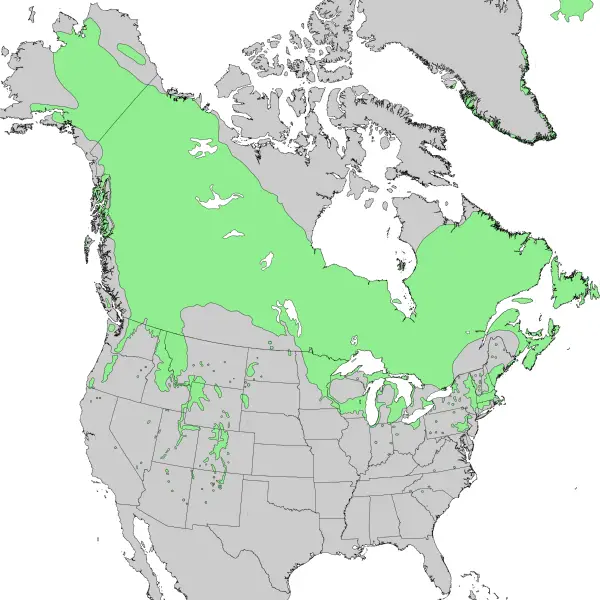
Common Juniper (Juniperus communis) range. Distribution map courtesy of the USGS Geosciences and Environmental Change Science Center, originally from "Atlas of United States Trees" by Elbert L. Little, Jr. .
Common Juniper (Juniperus communis). This is a nice example of what a mature Common Juniper would look like. (By: H. Zell GNU Free Documentation License, Version 1.2)
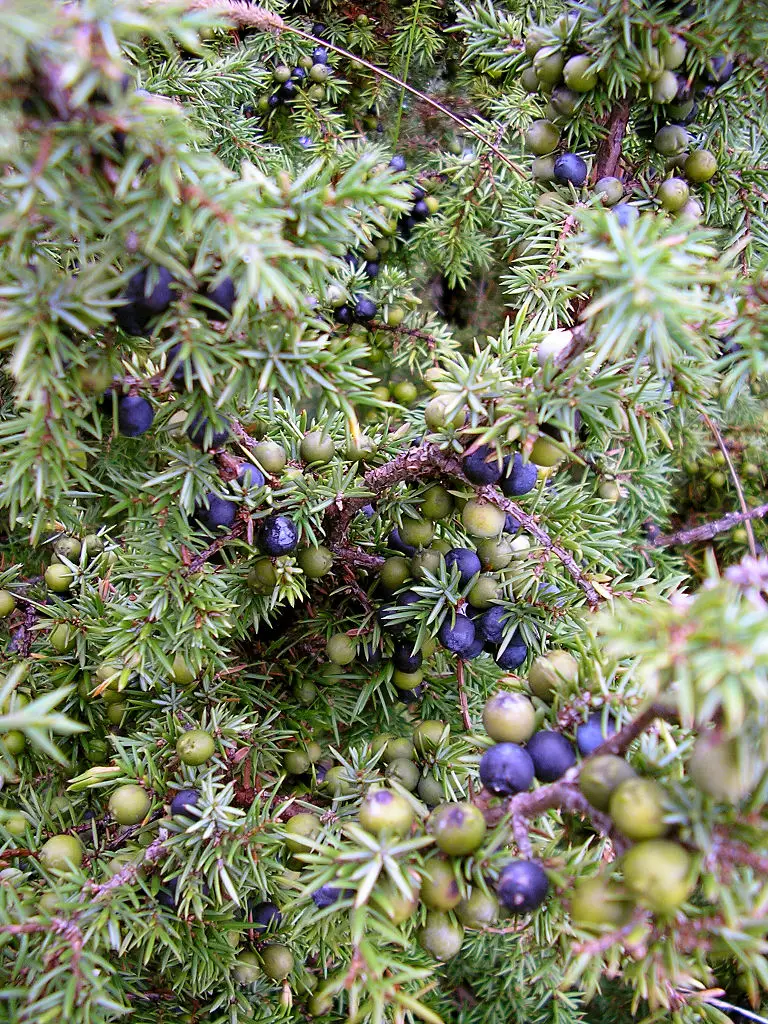
Common Juniper (Juniperus communis) with ripe (purple/blue) and unripe (green) berries. (By: Pt GNU Free Documentation License, Version 1.2)
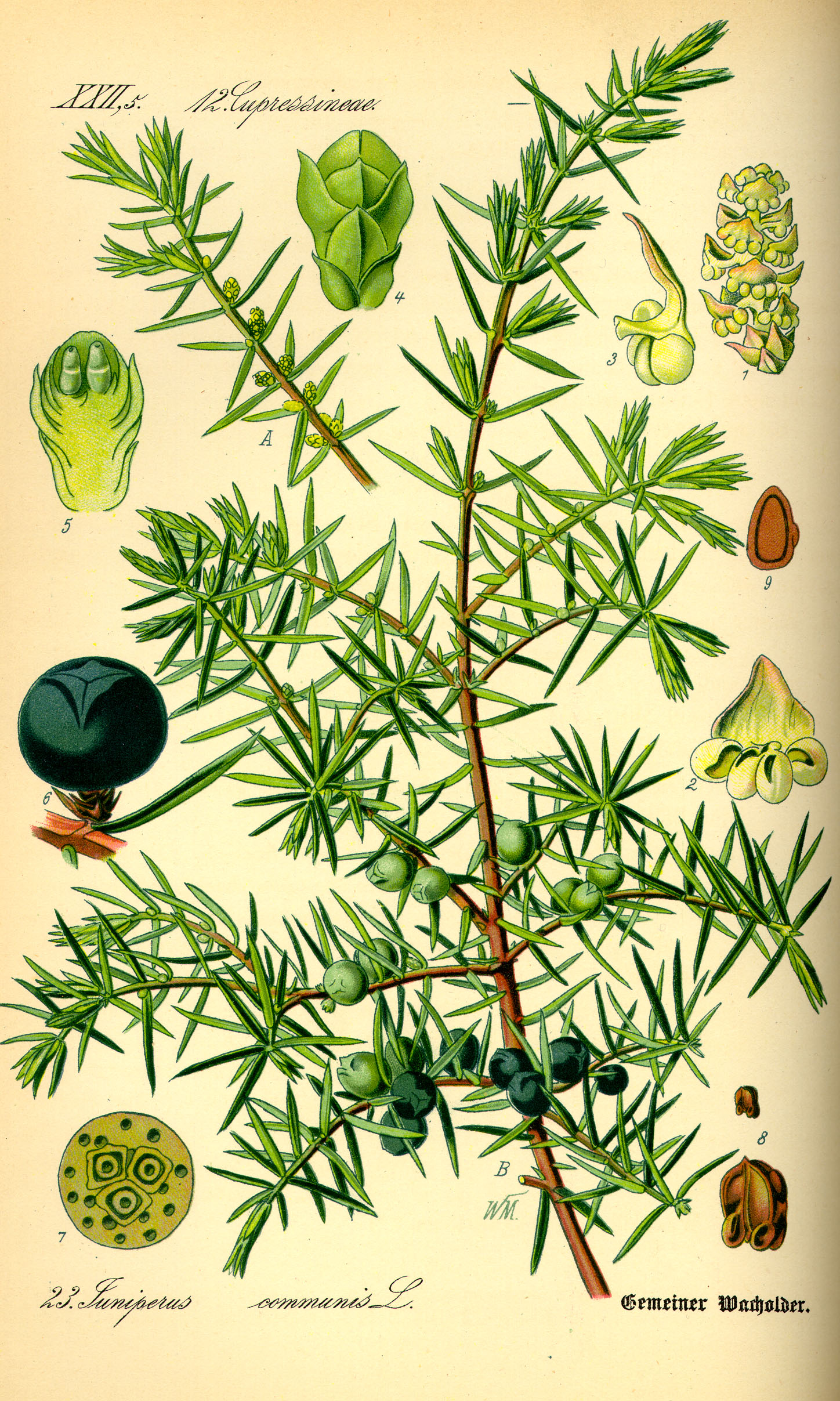
Common Juniper (Juniperus communis) illustration. I find the work from this 1885 book remarkable in the quality of detail (By: Prof. Dr. Otto Wilhelm Thomé Flora von Deutschland, Österreich und der Schweiz 1885, Gera, Germany)
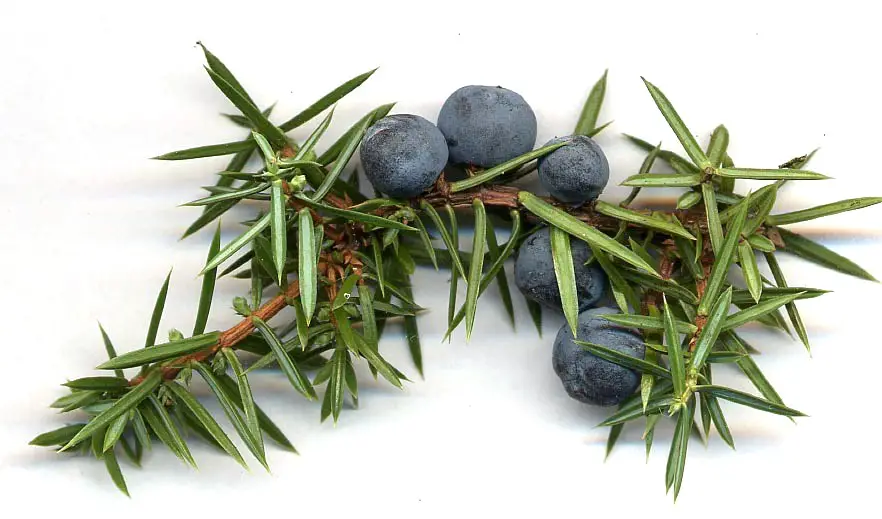
Common Juniper (Juniperus communis) ripe for harvest. These berries (actually they are conifer cones believe it or not) look to be perfect 2nd year ones which have better flavor. (By: MPF GNU Free Documentation License, Version 1.2)
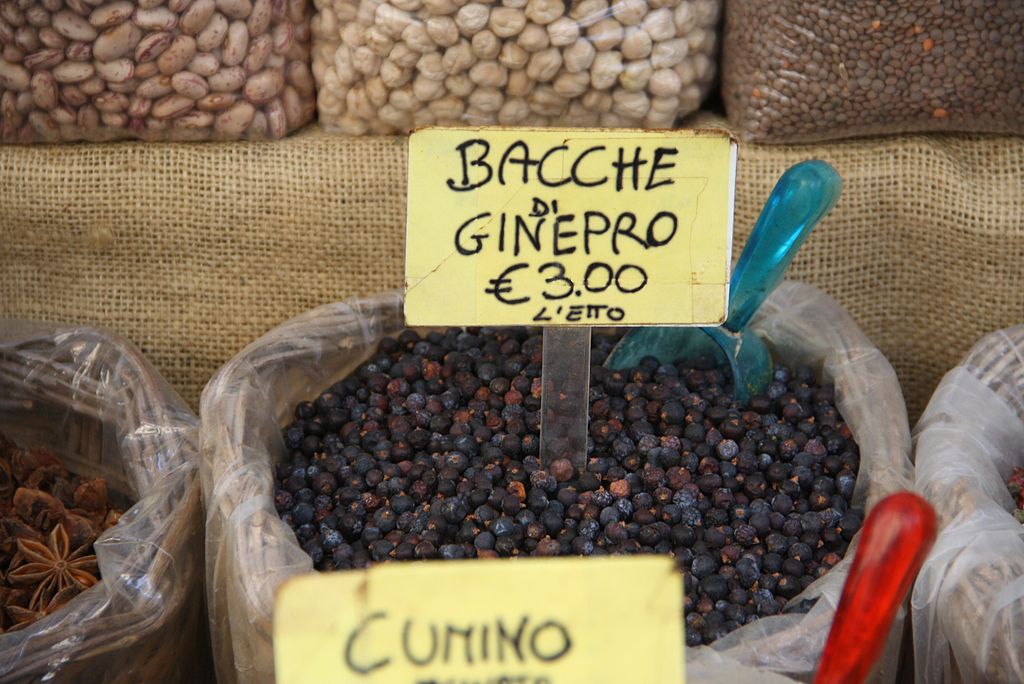
Common Juniper (Juniperus communis) berries (cones) dried and for sale in Italy in a market. (By: Giovanni Dall'Orto)
Creeping Juniper
Creeping Juniper (Juniperus horizontalis). Also known as the Creeping Cedar.
This one, and hybrids of it are sold at nurseries for rock gardens and ground cover type shrubs. If you are going to transplant or buy one for eating the berries, you have to make sure it is not a hybrid with one of the poisonous ones.
Description:
- USDA Plant Hardiness Zone: 3-9 (More information on hardiness zones).
- Soil pH: 4.5-8.5
- Plant Size: Up to 30 cm (1 foot) tall, but spreading very wide along the ground
- Duration: Long lived
- Leaf Shape: Adult: tiny overlapping scale like leaves. Seedlings: spike shaped leaves
- Leaf Phyllotaxis (Arrangement) on branch: Opposite pairs or wholes of three
- Leaf Size: Seedlings: up to 10 mm (inches). Adult: 1-1.5mm to 8 mm on terminal leaf
- Leaf Notes: Leaves on adult specimens grow like the adult leaves on the Chinese Juniper and Cedar tree leaves. New growth has a blue hue, while older leaves seem more green. There are cultivars that have colors that are not typical of what you would find in the wild - yellowish, green and variegated.
- Flowers: Male trees have small cones, females trees have the berry like cones
- Fruit: Small blue (green unripe) berry like cone. Fruit tastes basically the same as the Eastern Red Cedar
- Bark: Scaly reddish brown
- Habitat: Northern climates, but cultivars are sold in nurseries all over
Web Resources:
- Pictures of the Creeping Juniper on the web here (Google images) and here (Bing images).
- Pictures of the berries on the web here (Google images) and here (Bing images).
- Interactive USDA distribution map and plant profile here.
- The Biota of North America Program (BONAP) distribution map here. BONAP map color key here.
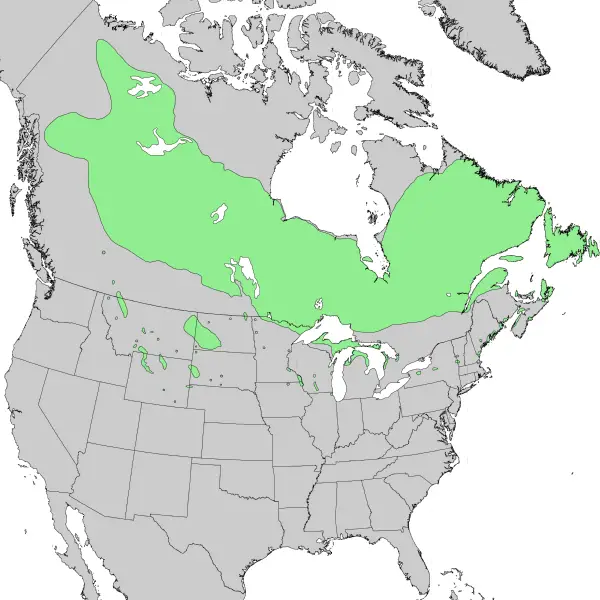
Creeping Juniper (Juniperus horizontalis) range. Distribution map courtesy of the USGS Geosciences and Environmental Change Science Center, originally from "Atlas of United States Trees" by Elbert L. Little, Jr. .
Creeping Juniper (Juniperus horizontalis). Good example of one and the type of area you are likely to find it. This one is from Newfoundland, Canada. (By: Wayne Ray)
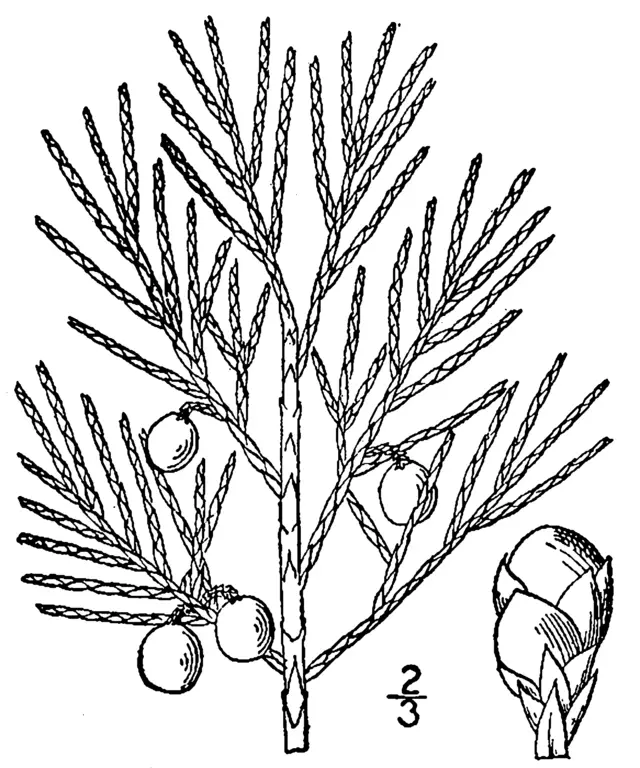
Creeping Juniper (Juniperus horizontalis) drawing. (USDA-NRCS PLANTS Database / Britton, N.L., and A. Brown. 1913. Illustrated flora of the northern states and Canada. Vol. 1: 67.)
Creeping Juniper (Juniperus horizontalis) close. (By: Lazaregagnidze Attribution-Share Alike 4.0 International license)
Chinese Juniper
Chinese Juniper (Juniperus chinensis). There are many cultivars and hybrids with this one and others, so keep that in mind with the description. For the most part, if you find a Juniper that was planted in the city, it has both kinds of leaves (scale like and spike like), you probably have this one, or a hybrid with it another - often a toxic one.
If you are buying this one for eating the berries, make very sure it is not a hybrid. The Pfitzer Juniper (Juniperus × pfitzeriana) is a very commonly sold hybrid, and the Juniper it is crossed with (Juniperus sabina) is toxic.
- USDA Plant Hardiness Zone: 5-9 (More information on hardiness zones).
- Soil pH: 5.5-8.0
- Plant Size: Shrub to tree that can reach 20 meters (65 feet) tall
- Duration: Can live for hundreds of years
- Leaf Shape: Juvenile leaves: needle like. Mature: Very small overlapping scale like leaf
- Leaf Phyllotaxis (Arrangement) on branch: On mature leaves, the scales are generally in opposite pairs
- Leaf Size: Juvenile leaves: 5–10 mm long. Mature: each scale like leaf is 1.5–3 mm long
- Leaf Notes: Although after the first few years of the tree, the leaves change from the juvenile to mature type, very often in shaded parts of the inner branches there will still be some juvenile type leaves growing.
- Fruit: Dark blue berry like cone often with whitish blue bloom (dusty coating that wipes off easily)
- Bark: Fresh growth is green, older branches reddish to almost purple reddish. Mature bark is light weathered grey to reddish with vertical lines and sometimes vertical shredding
- Habitat: In Eastern North America, will be found as landscape trees in city parks and private yards. Probably naturalized in North America, but I have not found specimens in the wild myself.
Web Resources:
- Pictures of the Chinese on the web here (Google images) and here (Bing images).
- Pictures of the berries on the web here (Google images) and here (Bing images).
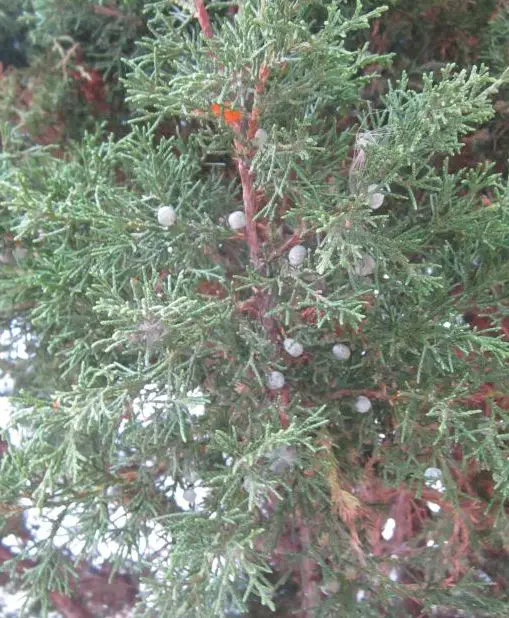
This is a Chinese Juniper (Juniperus chinensis). This is a typical city landscape use Juniper. The blueish, spherical “berries” look basically the same on the native Common Juniper.
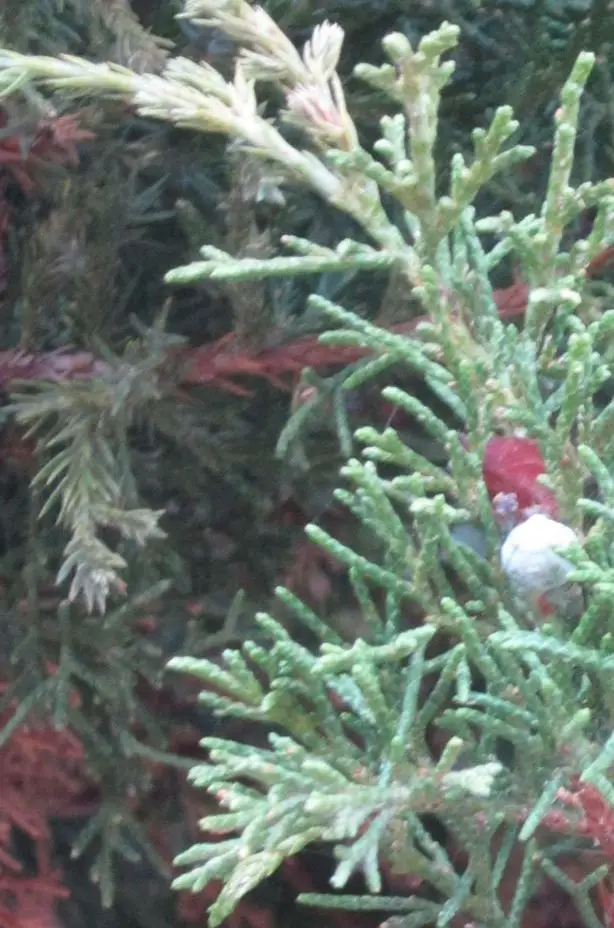
This picture shows a tree with both shapes of leaves on the Chinese Juniper (Juniperus chinensis). The leaves that are close with the berry in the center look like White Cedar leaves with a blue hue. But look on the very left side of the picture half way up. You can see the other kind of leaf that looks like individual “spikes” on a center stem. These spikey leaves are often called juvenile leaves, but persist into older trees in shaded areas of the tree - usually nearer the trunk.
Search Wild Foods Home Garden & Nature's Restaurant Websites:
Share:
Why does this site have ads?
Originally the content in this site was a book that was sold through Amazon worldwide. However, I wanted the information to available to everyone free of charge, so I made this website. The ads on the site help cover the cost of maintaining the site and keeping it available.
Google + profile
